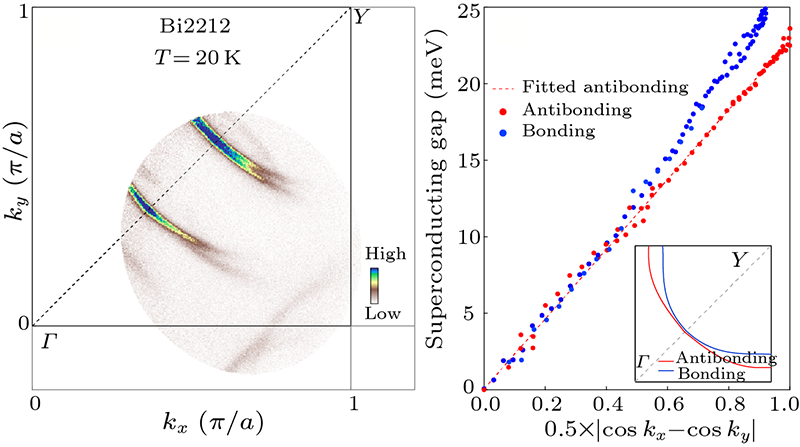| CONDENSED MATTER: ELECTRONIC STRUCTURE, ELECTRICAL, MAGNETIC, AND OPTICAL PROPERTIES |
 |
|

|
|
|
Distinct Superconducting Gap on Two Bilayer-Split Fermi Surface Sheets in Bi$_2$Sr$_2$CaCu$_2$O$_{8+\delta}$ Superconductor |
| Ping Ai1,2, Qiang Gao1,2, Jing Liu1,2, Yuxiao Zhang1,2, Cong Li1,2, Jianwei Huang1,2, Chunyao Song1,2, Hongtao Yan1,2, Lin Zhao1,2, Guo-Dong Liu1,2,5, Gen-Da Gu3, Feng-Feng Zhang4, Feng Yang4, Qin-Jun Peng4, Zu-Yan Xu4, Xing-Jiang Zhou1,2,5,6** |
1National Lab for Superconductivity, Beijing National Laboratory for Condensed Matter Physics, Institute of Physics, Chinese Academy of Sciences, Beijing 100190
2University of Chinese Academy of Sciences, Beijing 100049
3Condensed Matter Physics and Materials Science Department, Brookhaven National Laboratory, Upton, New York 11973, USA
4Technical Institute of Physics and Chemistry, Chinese Academy of Sciences, Beijing 100190
5Songshan Lake Materials Laboratory, Dongguan 523808
6Beijing Academy of Quantum Information Sciences, Beijing 100193 |
|
| Cite this article: |
|
Ping Ai, Qiang Gao, Jing Liu et al 2019 Chin. Phys. Lett. 36 067402 |
|
|
|
|
Abstract High resolution laser-based angle-resolved photoemission measurements are carried out on an overdoped superconductor Bi$_2$Sr$_2$CaCu$_2$O$_{8+\delta}$ with a $T_{\rm c}$ of 75 K. Two Fermi surface sheets caused by bilayer splitting are clearly identified with rather different doping levels: the bonding sheet corresponds to a doping level of 0.14, which is slightly underdoped while the antibonding sheet has a doping of 0.27 that is heavily overdoped, giving an overall doping level of 0.20 for the sample. Different superconducting gap sizes on the two Fermi surface sheets are revealed. The superconducting gap on the antibonding Fermi surface sheet follows a standard d-wave form while it deviates from the standard d-wave form for the bonding Fermi surface sheet. The maximum gap difference between the two Fermi surface sheets near the antinodal region is $\sim$2 meV. These observations provide important information for studying the relationship between the Fermi surface topology and superconductivity, and the layer-dependent superconductivity in high temperature cuprate superconductors.
|
|
Received: 30 April 2019
Published: 07 May 2019

|
|
| PACS: |
74.25.Jb
|
(Electronic structure (photoemission, etc.))
|
| |
74.72.Gh
|
(Hole-doped)
|
| |
79.60.-i
|
(Photoemission and photoelectron spectra)
|
| |
71.18.+y
|
(Fermi surface: calculations and measurements; effective mass, g factor)
|
| |
74.72.Hs
|
|
|
|
| Fund: Supported by the National Natural Science Foundation of China under Grant No 11888101, the National Key Research and Development Program of China under Grant Nos 2016YFA0300300 and 2017YFA0302900, the Strategic Priority Research Program (B) of the Chinese Academy of Sciences (XDB25000000), the Youth Innovation Promotion Association of CAS under Grant No 2017013, and the Research Program of Beijing Academy of Quantum Information Sciences under Grant No Y18G06. The work at Brookhaven was supported by the Office of Basic Energy Sciences, U.S. Department of Energy (DOE) under Contract No de-sc0012704. |
|
|
|
|
Viewed |
|
|
|
Full text
|
|
|
|
|
Abstract
|
|
|
|
|